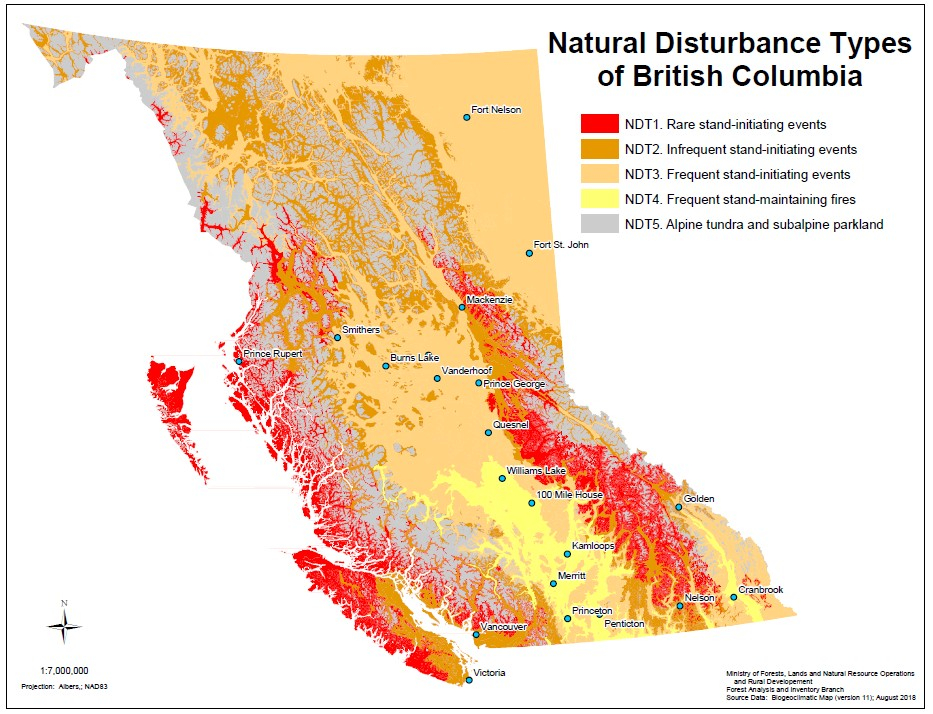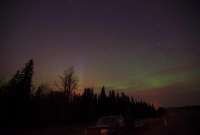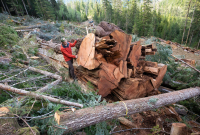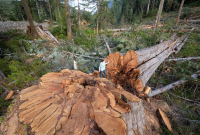Support strong Canadian climate journalism for 2025
Few people are aware that British Columbia’s beaten-up forests are now releasing more planet warming carbon dioxide than all other provincial sectors combined, or that these forest emissions are not counted as part of the total in provincial greenhouse gas inventories.
These massive and growing forest emissions are a result of destructive logging, beetle outbreaks and wildfires. B.C.’s forests stopped absorbing more carbon than they release in the early 2000s and uncounted forest emissions are now often greater than those that are counted.
The situation has gotten much worse in the last two years. Both the 2017 and 2018 wildfires burned more than 1.2 million hectares of the province, eight times more than the 10-year-average. B.C.’s 2017 fires caused an estimated 190 million tonnes of CO2 emissions. 2018 will be similar.
According to the last annual inventory (quietly released in December 2017) B.C.’s total emissions were about 63 million tonnes of carbon dioxide in 2015. Uncounted annual emissions from destructive logging were about 47 million tonnes in the last few years. In addition, there were roughly 8 million tonnes annually from slash burning in past years (they disappeared as "under review" in the last data released).
Fire emissions have skyrocketed and we must now expect to add roughly 190 million tonnes to the annual tally, for a yearly total of about 245 million tonnes of uncounted forest emissions (47+8+190). Our suffering forests were only capable of absorbing 28 million tonnes of carbon dioxide in 2015. The numbers we are able to access demonstrate that we can expect about 217 (47+8+190-28) million tonnes of "uncounted" annual carbon dioxide emissions from B.C.’s forests, once data becomes available.

The fact that forest emissions are not counted as part of the total is related to international agreements. And there is good reason to track them separately from emissions from burning fossil fuels, because some factors like fire and insects are difficult to control. It is important to be able to monitor how much we are reducing emissions from coal, oil and gas, without the ups and downs from forests muddying the picture. But this does not mean that we can hide forest emissions as if they don’t exist.
What's counted, matters
There is a simple step the province can take to address this issue — produce an additional report on forest carbon emissions. Here are two reasons why this is important:
First, B.C.’s growing forest emissions must be addressed with a package of urgent steps to reduce them as much as possible. Nobody will act if they remain hidden.
Second, the growing loss of carbon from our forests is signaling how severely climate impacts are already damaging the natural life support systems we depend on. We cannot ignore this deafening alarm any longer. It is this kind of ignorance that leads our governments to allow new pipelines and fracked LNG terminals that will massively increase emissions and make climate impacts even worse.

Keeping forest carbon emissions out of sight keeps them out of mind — one of the key reasons we have not yet seen any meaningful improvement in provincial forest stewardship, despite growing concern about climate change. In December, we are expecting the new B.C. climate strategy, but based on the previously shared intentions paper, we expect no forest climate strategy. The province has not even taken action to end slash burning, the lowest hanging fruit and a stark example of our hubris. Ending slash burning would be equivalent to reducing B.C.’s counted emissions by about 12 per cent.
Forest emissions data must be shown with at least as much detail as our counted emissions (for comparison, the provincial inventory includes more than 50 line items to offer detailed insight into the sources of our counted emissions, but only three numbers for all our uncounted forest carbon emissions).
Three important steps
To inform meaningful policy, forest emissions data must offer as much detail as possible with respect to the following three aspects. We need a particular focus on forest management and logging practices where we have the greatest ability to control emissions:
1. Data by region:
At a minimum and as a first step, all forest emissions should be shown for all five ecozones in B.C. — the Pacific Maritime, the Montane Cordillera Ecozone, the Boreal Cordillera Ecozone and the Boreal Plains and Taiga Plains ecozones. We need as much regional detail as possible to help inform land use planning in areas like Vancouver Island.
2. Data by forest type and distinction between intact and logged forests:
The most important distinction to inform policy must be between forests that show low levels of natural disturbance and forests with high levels of natural disturbance.
The damage inflicted on B.C.’s forests from the mountain pine beetle and wildfires highlights that not all forests are the same. B.C. Interior forest ecosystems with a certain level of natural disturbance from fire and insects, increasingly worsened by climate change, are now the hardest hit.
In contrast, B.C.’s old-growth coastal and Interior temperate rainforests contain ancient trees many hundreds of years old. These forests can store over 1,000 tonnes of carbon per hectare, one of the highest rates on earth. They are like a carbon bank, accumulating carbon in soil, trees, and organic matter over millennia. We need detailed data to inform what forests should be protected to mitigate massive carbon loss from clearcutting carbon rich resilient forests.

In addition, data should distinguish between emissions from unlogged/intact forests and logged/managed forests. Research shows that most natural forests are better carbon sinks than managed forests.
3. Data by management practices:
We urgently need data that accurately compares emissions from various types of logging, distinguishing destructive practices from lighter touch and selective logging. Second-growth forests can be harvested selectively in a manner that will allow for negative emissions – harvesting trees while increasing the amount of carbon in the forest at the same time, by constantly improving growth conditions for standing trees.
Emissions from logging carbon rich old-growth could be reduced quickly by using some of the solutions developed in the Great Bear Rainforest as promised by the NDP in their 2017 election platform, combined with support for First Nations land use planning and a rapid transition to improved management of second-growth forests.
B.C. forest management is making climate change worse — an alarming situation when our forests should instead be our best ally in the fight against climate change. Unless the BC government wakes up and takes far-reaching action to strengthen conservation and improve forest management, our provincial forests will continue to contribute to climate change instead of slowing it down. Sharing detailed information to inform forest climate strategies at all levels of government will be a crucial first step.






Comments
So far the NDP government in BC (and Alberta) talked the talk while in opposition but not walked the walk in power. Proving that in the final analysis they are just as invested in the neo liberal agenda and status quo as the Liberals and Conservatives. It seems clear that humanitys prospects for survival remains tenuous at best as long as we and those we elect cling to a system that in its very essence places profit, greed,growth and waste ahead of all other considerations.
Yet again, how important is scientific investigation and reporting in advising policy?? Even school kids know that, once you leave out some facts, the end result is a disaster!!
As with the California fires - the west coast in flames is yet more proof of the climate change feedback loop that scientists have been warning about. The further we slide down this slope the stronger the feedback loop disasters. If the world's scientists and governments were capable of doing accurate measurements of the emissions I bet that 12 years of grace would shrink drastically.
"Keeping forest carbon emissions out of sight keeps them out of mind".
That's exactly the policy adopted by the federal government regarding greenhouse gas emissions from "natural disturbances" which include emissions resulting from forest fires, insect infestations, and wind throw (impacts of natural disturbances with greater than 20% tree mortality).
GHG emissions used to be included in the "Land Use, Land-Use Change and Forestry (LULUCF) sector in Canada's National Inventory Report to the UNFCCC. They are not anymore.
"The Land Use, Land-Use Change and Forestry (LULUCF) Sector reports "anthropogenic" GHG fluxes between the atmosphere and Canada's managed lands (226 million hectares, or 65% of Canada's total forest area), including those associated with land-use change and emissions from Harvested Wood Products (HWP), which are closely linked to Forest Land.
In this sector, the net flux is calculated as the sum of CO2 and non-CO2 emissions to the atmosphere and CO2 removals from the atmosphere. In 2015, this net flux amounted to removals of 34 Mt (CO2e), which if included, would decrease the total Canadian GHG emissions by 4.6%. New this year, the LULUCF estimates now exclude the impact of significant natural disturbances in managed forests (wildfires and insects), revealing more meaningful trends associated with anthropogenic activities..."
(source: "Canada's National Inventory Report to the UNFCCC, 1990-2015, April 2017: Greenhouse Gas Sources and Sinks in Canada."
The exclusion of GHG emissions from "natural disturbances" in Canada's report to the UNFCCC is not new. The federal government has already wrote about it in its 2016 report to the UNFCCC. In fact, that decision was made by the previous Harper government: " In a spring 2012, submission to the UNFCCC, Canada, along with a number of other countries, stated its intent to include the LULUCF sector in its accounting of GHG emissions towards its 2020 target, noting that emissions and related removals resulting from "natural disturbances" would be excluded from the accounting."
(source: Environment Canada, 2013: "The Land Use, Land-Use Change and Forestry Sector")
Since the Trudeau government has adopted the same emissions reductions target from the previous government for 2020 and 2030, does it mean that these supposed "emissions reductions" (estimated at -34Mt in 2015) will be included in the 2020 report to the UNFCCC? That would certainly help Canada to reach its emissions reductions target which are far from being attained; but that would be a lie. The federal government by omitting voluntarily to take into account GHG emissions from "natural disturbances" is saying that human activities (including climate change) have no impact on forest fires.
In 2015, Natural Resources Canada's Canadian Forest Service has estimated total net emissions (source minus removals) of carbon dioxide equivalent (CO2e) from Canada's managed forest at about 221 million tonnes (Mt). If accounted Canada's total GHG emissions would have reached 943 Mt instead of the "official" estimate of 722 Mt.
(source: Natural Resources Canada, 28/09/2017, Indicator: "Forest carbon emissions and removals")
we are beginning the 6th great extinction death spiral = positive feedback phase , even in 2015 emissions >capture : https://www.nrcan.gc.ca/forests/report/disturbance/16552?fbclid=IwAR0U-…